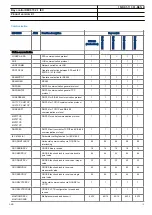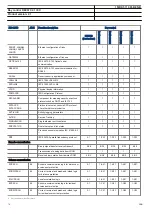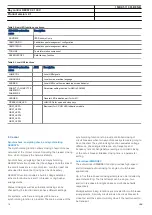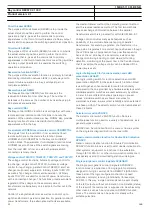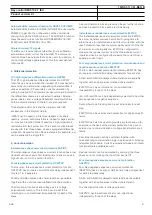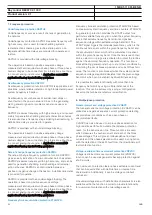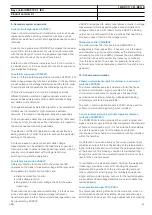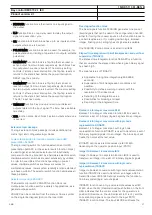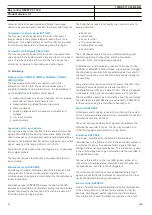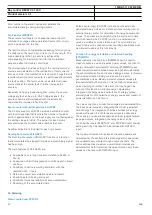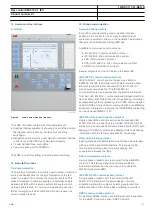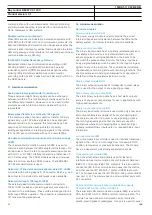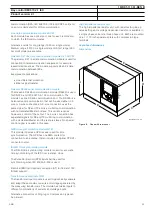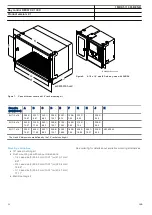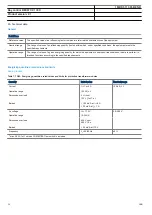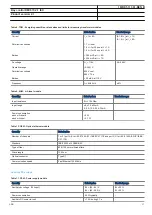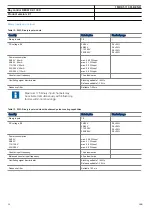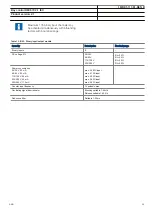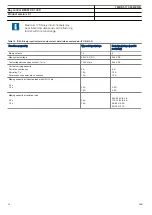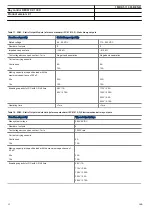
term (for example corrective actions) and in the long term (for
example functional analysis).
The event recorder logs all selected binary input signals
connected to the Disturbance recorder function. Each
recording can contain up to 150 time-tagged events.
The event recorder information is available for the
disturbances locally in the IED.
The event recording information is an integrated part of the
disturbance record (Comtrade file).
Trip value recorder DRPRDRE
M12128-3 v7
Information about the pre-fault and fault values for currents
and voltages are vital for the disturbance evaluation.
The Trip value recorder calculates the values of all selected
analog input signals connected to the Disturbance recorder
function. The result is magnitude and phase angle before and
during the fault for each analog input signal.
The trip value recorder information is available for the
disturbances locally in the IED.
The trip value recorder information is an integrated part of the
disturbance record (Comtrade file).
Disturbance recorder DRPRDRE
M12156-3 v10
The Disturbance recorder function supplies fast, complete
and reliable information about disturbances in the power
system. It facilitates understanding system behavior and
related primary and secondary equipment during and after a
disturbance. Recorded information is used for different
purposes in the short perspective (for example corrective
actions) and long perspective (for example functional
analysis).
The Disturbance recorder acquires sampled data from
selected analog- and binary signals connected to the
Disturbance recorder function (maximum 40 analog and
binary signals). The binary signals available are the same as
for the event recorder function.
The function is characterized by great flexibility and is not
dependent on the operation of protection functions. It can
record disturbances not detected by protection functions. Up
to ten seconds of data before the trigger instant can be saved
in the disturbance file.
The disturbance recorder information for up to 100
disturbances are saved in the IED and the local HMI is used
to view the list of recordings.
Event function
M12805-6 v9
When using a Substation Automation system with LON or
SPA communication, time-tagged events can be sent at
change or cyclically from the IED to the station level. These
events are created from any available signal in the IED that is
connected to the Event function (EVENT). The event function
block is used for LON and SPA communication.
Analog and double indication values are also transferred
through EVENT function.
Generic communication function for Single Point indication
SPGAPC
SEMOD55713-5 v7
Generic communication function for Single Point indication
SPGAPC is used to send one single logical signal to other
systems or equipment in the substation.
Generic communication function for Measured Value
MVGAPC
SEMOD55872-5 v9
Generic communication function for Measured Value
MVGAPC function is used to send the instantaneous value of
an analog signal to other systems or equipment in the
substation. It can also be used inside the same IED, to attach
a RANGE aspect to an analog value and to permit
measurement supervision on that value.
Measured value expander block RANGE_XP
SEMOD52450-4 v7
The current and voltage measurements functions (CVMMXN,
CMMXU, VMMXU and VNMMXU), current and voltage
sequence measurement functions (CMSQI and VMSQI) and
IEC 61850 generic communication I/O functions (MVGAPC)
are provided with measurement supervision functionality. All
measured values can be supervised with four settable limits:
low-low limit, low limit, high limit and high-high limit. The
measure value expander block (RANGE_XP) has been
introduced to enable translating the integer output signal from
the measuring functions to 5 binary signals: below low-low
limit, below low limit, normal, above high limit or above high-
high limit. The output signals can be used as conditions in the
configurable logic or for alarming purpose.
Gas medium supervision SSIMG
GUID-0692CD0D-F33E-4370-AC91-B216CAAAFC28 v5
Gas medium supervision SSIMG is used for monitoring the
circuit breaker condition. Binary information based on the gas
pressure in the circuit breaker is used as input signals to the
function. In addition, the function generates alarms based on
received information.
Liquid medium supervision SSIML
GUID-3B1A665F-60A5-4343-85F4-AD9C066CBE8D v5
Liquid medium supervision SSIML is used for monitoring the
circuit breaker condition. Binary information based on the oil
level in the circuit breaker is used as input signals to the
function. In addition, the function generates alarms based on
received information.
Breaker monitoring SSCBR
GUID-E1FD74C3-B9B6-4E11-AA1B-7E7F822FB4DD v10
The breaker monitoring function SSCBR is used to monitor
different parameters of the breaker condition. The breaker
requires maintenance when the number of operations reaches
a predefined value. For a proper functioning of the circuit
breaker, it is essential to monitor the circuit breaker
operation, spring charge indication or breaker wear, travel
1MRK 511 361-BEN B
Bay control REC670 2.1 IEC
Product version: 2.1
ABB
29

